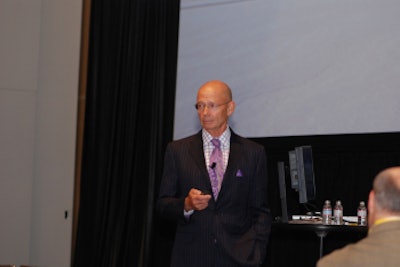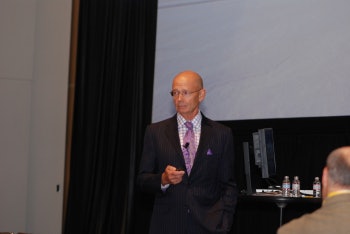
William Blatchford, D.D.S., had a successful practice but he wasn't truly happy. He worked five days a week, never had time for vacations, and always felt a cloud of stress hanging over him. One night while eating leftovers from yet another office dinner, his wife and fellow dentist, Carolyn, said, "We're eating the leftovers of the practice's revenues every month." One night, Blatchford had a realization: He needed to change the entire way he ran his business.
Once he did, Blatchford claims he eventually climbed to the top 1 percent of highest-grossing dentists nationwide. Then he founded Blatchford Solutions and became a coach and consultant to 2,500 dental practices. His selling point: Life is too short, so develop a practice that allows you the lifestyle you desire. When he is not flying planes; skiing near his Bend, Oregon home; or sailing in Puget Sound; Blatchford spreads the word about his theory.
 |
| Dr. William Blatchford |
His "Show Me the Money" session at the recent ADA conference in San Francisco was a few years in coming. "Two years ago, the ADA told me not to talk about profit or use the 'S-word' at the conference." (We're assuming he meant "sell".) "This year, they actually requested I do this program. It shows how far the dental business has come."
One of his seemingly contrary discoveries: Customer service demands that you focus on income. "People want to go to a dentist who is profitable. They don't want a dentist working on their teeth who is preoccupied with paying the rent."
Cut back on overhead
What keeps dentists from boosting profits? They're bad at estimating what to expect to gross every month, says Blatchford. "A dentist has one month that's shockingly big and assumes it will always be like that and spends money on more staff and equipment. The next month, business goes back to normal and he's worrying about paying expenses. What did the dentist do to make that one month so big? Chances are, they don't know.
"Your 'range of predictability' shouldn't go up and down. It should become narrower."
In Blatchford's case, he scrutinized his staffing. He had 16 employees, five solely for hygiene. ("What does one dentist need 16 employees for?") He laid off three hygienists ("The worst day of my career"), then later cut his total staff to eight. A year later, he grossed slightly more than the prior year, even with half his staff.
Blatchford boasts that his clients gross between $2 to $3 million annually, even when working with staffs of five or fewer. More telling? His dentists work 3.5 days a week and take eight to 10 weeks vacation a year. All of them have cut their overhead and reduced their staff to a handful. "It's not about time spent or efforts made, or even how much you work. It's about results."
Getting there means cutting the small stuff, focusing on high-end treatments, and developing specialized niches. One of Blatchford's clients moved his dental practice to Florida and focused on cosmetic dentures and implants for the abundant population of well-heeled seniors. The dentist charges $6,000 to $10,000 a pop. The results: He went from grossing $800,000 a year to $2 million, with half his previous overhead (a team of five employees), and a four-day workweek.
Another client only works three mornings a week, but she focuses on dentures and implant-supported dentures in a Polish neighborhood in Chicago. "She doesn't do fillings or see kids," says Blatchford. "But she earns so much in her specialty that she throws in a spare set of dentures for free." She likewise trimmed staff, cutting overhead from 63 percent to 37 percent, and grosses $1 million annually.
Typically, 30 percent of a dentist's overhead is staff. Blatchford says it should be 12 to 20 percent. But pay those staffers you keep well--double their salaries. "I once hired someone incompetent and then had to hire a trainer to help her. That's stupid." Hire the most competent staff, give them incentives of higher pay and a reduced workweek, and they'll give you hard work and loyalty in return.
Focus on your top clientele
Blatchford is a firm believer that the top 20 percent of patients generate 80 percent of your income--and that the bottom 20 percent can actually be an income drain. "It's ludicrous to treat all patients the same when some are actually costing you money."
He suggests you create a spreadsheet of all your patients and how much they spend, then list them in descending order of expenditures. "When the descending total hits 80 percent of total income, study those people in that range. Look at their age, gender, and treatments needed -- that's your target market. Get rid of the bottom 20 percent."
Raise fees, lower receivables
Don't be afraid to raise fees, either. Blatchford actually recommends doubling them. "People go to my Chicago-based client because her dentures cost twice as much. They perceive it as quality."
If you're hesitant to double, add the bill cost to your current fee. "Then you can send work to the best lab around, because the patient is paying for it directly."
Accounts receivables are poison in his book. Say you have $100,000 in A/R on Jan.1. Over the course of a year, you'll lose $6,000 through inflation, $10,000 from money you could have invested (if you had it), $36,000 in the costs of trying to get patients to pay, and $24,000 in write-off of bad debts. By year's end, you will have lost $76,000.
"That's why my clients do not carry account receivables," says Blatchford. "It's check, cash or credit card upfront at the desk."
Make treatments affordable by offering financing options from outside sources. Why not?, says Blatchford. "That's how they pay for their car and big-screen TV."
Ply them with services
Consultants often tell dentists to focus on getting more hygiene patients, but Blackford says forget that. "You'll only break even. It will never be a profit center."
Instead, focus on doing more Class II and Class III procedures. "If you do two units of a crown or bridge, your net profit per hour triples." He also recommends offering additional services, such as denture implants, cosmetic dentures, and veneers.
How can you get patients to accept these offerings? "McDonald's made millions by asking, 'Do you want fries with your burger?'" says Blatchford. "Say to your patient during a procedure, 'I notice you'll need an additional crown here soon. We can get both done while you're still numb and save you two extra appointments.'"
Instead of trying to educate patients about treatments' benefits, appeal to their emotions. "People don't want dentures or veneers, they want their teeth to look good, feel good and last a long time. Instead of trying to sell the process, you should be selling the results."
Moneymaking aside, Blatchford emphasizes that all dentists should balance business and pleasure, and ensure that they can incorporate both into their practice. "Life is too short. Make a commitment to be happy. You should say, 'Thank God it's Monday!' Focus only on the things you want to do and enjoy them, both in work and life."



















